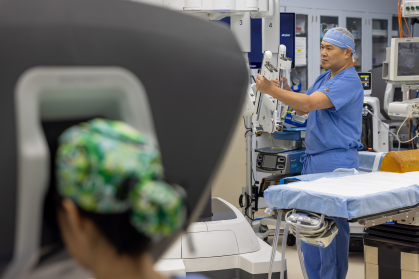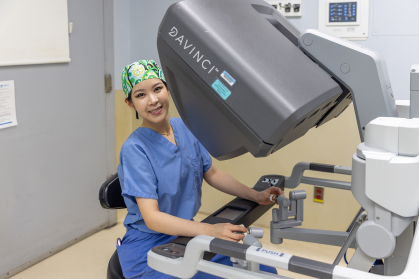Two surgeons at Rutgers New Jersey Medical School are the first in the state to use robotics in breast reconstruction after cancer treatment. Surgery with the robot is less invasive than traditional surgery, so patients typically heal faster and have smaller scars.
Edward Lee, a plastic surgeon, and Danbee Kim, a robotic surgeon, are the first to perform the procedure in New Jersey, and they believe it will significantly improve patient outcomes. More importantly, they think it demonstrates that robotic machines may soon improve many other reconstructive surgeries.
"This is just the beginning," said Lee, a division chief who also directs the school's plastic surgery residency training program. "We're exploring ways to use the robot for thigh muscle harvests, abdominal flaps and more. The potential to improve outcomes across reconstructive procedures is enormous."
The pair began with the breast surgery, known as a latissimus dorsi flap reconstruction, several months ago. The procedure removes muscles from the patient's upper back to help replace tissue lost to mastectomy, a breast-removing cancer treatment.
This type of reconstructive surgery has traditionally required a long incision stretching halfway across the back that takes months to heal and leaves a large scar. The surgical robot allows them to cut under the patient's armpit and access the back muscle without any incision on the back. This technique does less damage, so patients heal faster and with less scarring.
"The robot has four arms, one for a camera and three more you can manipulate to operate. If you've ever hung a painting, you'll know how nice it would be to have a third arm," Kim said.
The extra arms also reduce the need for surgical support staff who typically hold cameras, retractors and other surgical tools, so robotic surgery could potentially cut medical costs going forward.
"And the robot camera's high-definition allows us to better identify tissue and perform more precise surgeries than in traditional surgery," Kim continued.
Breast reconstruction alone is a significant potential use case for robotic surgery. Surgeons in the U.S. perform more than 100,000 reconstructions every year after cancer treatment. Latissimus dorsi flap surgeries are only one of many techniques for reconstructing breast tissue, but they are a common procedure for patients who will receive radiotherapy after cancer removal.

"Radiation cooks the skin and tissue, making it shrivel and tighten," Lee said. "Adding an extra layer of soft tissue to the surgery site provides more padding to the implant that provides most of the volume in the reconstruction."
The robot-assisted surgery initially took longer than traditional surgery, but Lee and Kim have seen operative times decrease with experience. Other surgeons using the robot for other surgeries like prostate removal, colon cancer, and other surgeries see a similar learning curve.
"We're building on the innovative work of our international colleagues," said Kim, who trained in South Korea. "Our goal is to refine the technique, expand its applications and make it more widely available to patients who can benefit from it."
Robotic surgeries were slow to catch on - the surgical robot from Da Vinci, which dominates the U.S. market, appeared in 2000 but was used in less than 1% of surgeries a decade later - but their popularity has exploded in recent years. Robotic surgery now accounts for 22% of all U.S. surgeries, with its application to different types of surgeries rapidly expanding
Ultimately, robotic surgery may replace human surgeons, at least in part. A new presentation from Johns Hopkins showed that AI-equipped surgery robots could learn to do some surgical procedures automatically after watching surgeons perform.
Even now, existing robots may enhance productivity by reducing the physical demands of surgery. Unlike traditional procedures, which force surgeons to stand for hours, robotic surgery can be performed from the comfort of a chair.
The robot's control panels typically sit in the operating room but can be anywhere with an internet connection. At least one patient needing a rare procedure has already undergone surgery from an expert half a world away.
The robotic technique also helps experienced surgeons train students and residents. The system features dual consoles, allowing a teacher to guide a resident through the procedure in real time.
"There are actually two consoles, one that the surgeon uses and a duplicate in a different area of the room," Kim said. "This lets your residents or anyone else you're training sit in the same position and see exactly what the surgeon sees. If you need a second qualified surgeon, they can also work on the robot simultaneously.
"At the end of every case, the robot sends information to the apps on our phones that track all the time spent by the student, the teaching surgeon and how many moves each one made. That information helps you gradually give trainees more autonomy and track our progress so that we can constantly improve our techniques."
As with any new surgical technique, questions remain about long-term outcomes and cost-effectiveness. The Rutgers team is studying their results and plans to publish their findings to contribute to the growing evidence surrounding robotic reconstruction.

"We're carefully tracking our outcomes and plan to publish a case series once we have more data," said Kim. "It's crucial that we demonstrate not just the feasibility of this approach, but its long-term benefits for patients."
While the robotic technique shows promise, both surgeons emphasize that it's not appropriate for every patient. For example, the robot's ability to cut less skin provides no advantage in procedures where surgeons must transfer a significant amount of skin to the repair site.
Careful patient selection and thorough discussion of all reconstructive options remain important factors in the decision-making process.
"In the end, it's all about providing our patients with the best possible results and experience," said Lee. "If we can achieve that with smaller scars and faster recoveries, that's a win for everyone involved."






